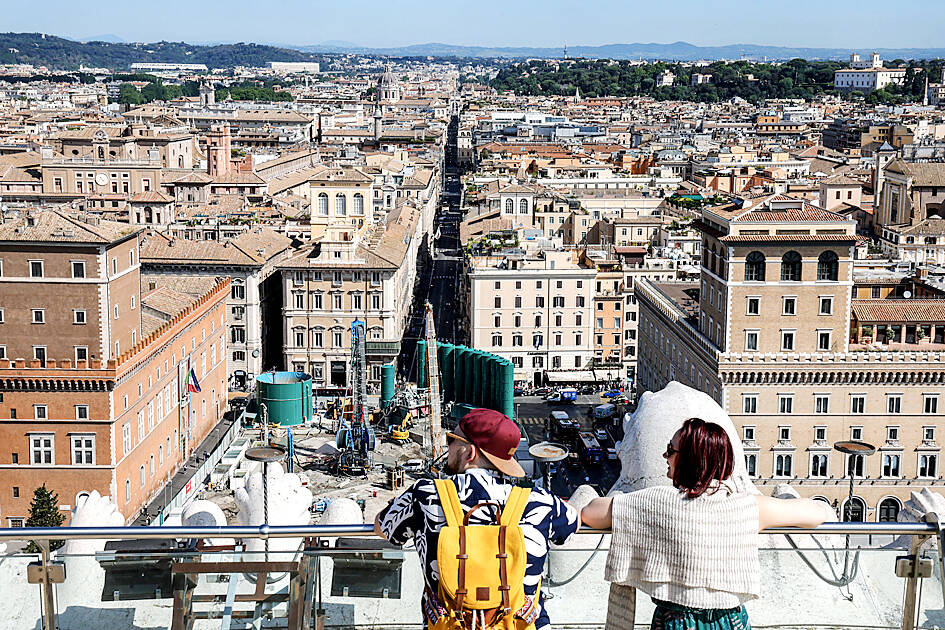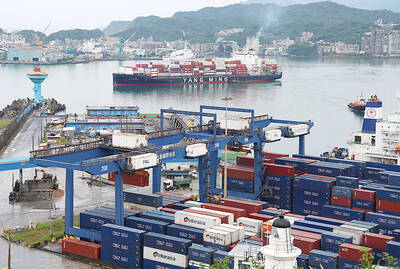Having made property investments in Milan, Italy, Italian architect Giuseppe Pezzano is now looking for a place in Rome to set up a second home and studio, as the capital’s underdeveloped real-estate sector draws fresh attention.
Pezzano’s property hunt highlights a wider shift that has put Rome in the sights of professional real-estate investors, after the Milan area took more than half of their investments in Italy in the past five years, data by Scenari Immobiliari think tank showed.
Sky-high prices and judicial probes into the fast-tracking of building permits have put a brake on the market in Italy’s financial capital, just as public spending in Rome for the Roman Catholic Holy Year and a friendlier attitude from the local administration draw in investors spotting a bargain.

Photo: EPA-EFE
“In Milan, 400,000 euros [US$418,430] gets you an ugly one-bedroom, in Rome you can live in a late 19th-century building,” Pezzano said.
“Rome’s architecture, its open views and its people make it the world’s most beautiful city. I want a window that looks out onto that beauty. And I think I can find new clients there. Rome is on the cusp of an architectural renaissance.”
Rome accounted for 17 percent of all professional real-estate investments last year in Italy, up from an average of 11 percent over the 2020-2024 period, data by property services firm JLL showed.
Professional property investors poured 1.7 billion euros into Rome projects last year, double the 2023 figure. The Holy Year, which is forecast to add an extra 10 million tourist arrivals to last year’s 22 million record, has fueled up to 8 billion euros of public spending to refurbish central areas and strengthen infrastructure.
To promote urban renewal across a city dotted with ancient ruins and some of the world’s most spectacular churches and fountains, Rome in December last year approved new town planning rules, which it had last updated in 2008.
The city is also striving to narrow the gap with Italy’s more efficient financial capital and ease residents’ daily struggles with public transport, potholed roads and uncollected rubbish.
Global real-estate investment manager Hines is working to secure its first Rome project, after focusing on the north of Italy until now.
“We believe Rome has the potential to experience the real-estate renaissance that Milan has undergone over the past decade,” Hines Italy head Mario Abbadessa said.
The gap between the 12,000 to 14,000 euros per square meter commanded by an apartment in the center of Milan, and the 8,000 to 9,000 euros of an equivalent property in Rome is “excessive,” Abbadessa said.
Rome is also cheaper than other southern European capitals such as Lisbon or Athens.
The 2015 World Expo ushered in a property boom in Milan with house prices up 27 percent in 2014 to 2024 on average, or 52 percent in semi-central areas, consultancy PwC calculated.
By contrast, Rome’s house prices declined by 14.4 percent over the past decade, according to think tank Nomisma.
Investors see value. Rome accounts for the bulk of Czech firm CPI Property Group’s investments in Italy, which have reached 1.5 billion euros from 53 million in 2018, a person with knowledge of the matter said.
On a smaller scale, Rome projects worth 30 million euros make up more than half of Italian group Hera Holding’s property portfolio, up from one-fifth in 2018.
Rome City Councilor Maurizio Veloccia said that Rome has had to restore its credibility with investors.
Many Rome builders, often small, family-owned firms, did not survive the recessions Italy suffered from 2008 to 2013.
“And outsiders were not interested in stepping in because of the bureaucracy risk,” Veloccia said. “Projects stalled half-way, and this reflected badly with public opinion, reinforcing the idea that real-estate investments are a danger.”
Marking a shift in attitude, Rome reopened to the public its urban planning department, which had become digital-only during the COVID-19 pandemic.
To reduce risks and costs for investors faced with lengthy and uncertain approval processes, the administration boosted its decisionmaking powers. It also lifted restrictions, such as a cap of 60 rooms for hotels in the city center, and removed 700 buildings from a list of protected properties that hindered renovation.
“With the jubilee acting as a catalyst, Rome must now prove it can address the issues that have for so long held back real-estate investments,” Scenari Immobiliari director general Francesca Zirnstein said.
Some stranded construction projects are getting a second lease of life.
One example is the “Ex Fiera di Roma” site, a 76,000m2 former convention center area whose renovation has stalled for 20 years.
A fund backed by banks UniCredit and Illimity owns the site, and developer ARECneprix is turning more than half the area into buildings, mostly residential, including a portion of social housing. Social housing is key to Rome’s efforts to avoid following in Milan’s tracks, where residents are being priced out as wealthy foreigners making use of tax benefits flock in.
Rome’s size is seen as a further defense against gentrification.
“I don’t see Rome becoming a new Milan, it’s too big and full of families and students, not high-flying professionals,” Rome resident Paola Salvetti said.

CHIP RACE: Three years of overbroad export controls drove foreign competitors to pursue their own AI chips, and ‘cost US taxpayers billions of dollars,’ Nvidia said China has figured out the US strategy for allowing it to buy Nvidia Corp’s H200s and is rejecting the artificial intelligence (AI) chip in favor of domestically developed semiconductors, White House AI adviser David Sacks said, citing news reports. US President Donald Trump on Monday said that he would allow shipments of Nvidia’s H200 chips to China, part of an administration effort backed by Sacks to challenge Chinese tech champions such as Huawei Technologies Co (華為) by bringing US competition to their home market. On Friday, Sacks signaled that he was uncertain about whether that approach would work. “They’re rejecting our chips,” Sacks

Taiwan’s exports soared 56 percent year-on-year to an all-time high of US$64.05 billion last month, propelled by surging global demand for artificial intelligence (AI), high-performance computing and cloud service infrastructure, the Ministry of Finance said yesterday. Department of Statistics Director-General Beatrice Tsai (蔡美娜) called the figure an unexpected upside surprise, citing a wave of technology orders from overseas customers alongside the usual year-end shopping season for technology products. Growth is likely to remain strong this month, she said, projecting a 40 percent to 45 percent expansion on an annual basis. The outperformance could prompt the Directorate-General of Budget, Accounting and

NATIONAL SECURITY: Intel’s testing of ACM tools despite US government control ‘highlights egregious gaps in US technology protection policies,’ a former official said Chipmaker Intel Corp has tested chipmaking tools this year from a toolmaker with deep roots in China and two overseas units that were targeted by US sanctions, according to two sources with direct knowledge of the matter. Intel, which fended off calls for its CEO’s resignation from US President Donald Trump in August over his alleged ties to China, got the tools from ACM Research Inc, a Fremont, California-based producer of chipmaking equipment. Two of ACM’s units, based in Shanghai and South Korea, were among a number of firms barred last year from receiving US technology over claims they have

BARRIERS: Gudeng’s chairman said it was unlikely that the US could replicate Taiwan’s science parks in Arizona, given its strict immigration policies and cultural differences Gudeng Precision Industrial Co (家登), which supplies wafer pods to the world’s major semiconductor firms, yesterday said it is in no rush to set up production in the US due to high costs. The company supplies its customers through a warehouse in Arizona jointly operated by TSS Holdings Ltd (德鑫控股), a joint holding of Gudeng and 17 Taiwanese firms in the semiconductor supply chain, including specialty plastic compounds producer Nytex Composites Co (耐特) and automated material handling system supplier Symtek Automation Asia Co (迅得). While the company has long been exploring the feasibility of setting up production in the US to address